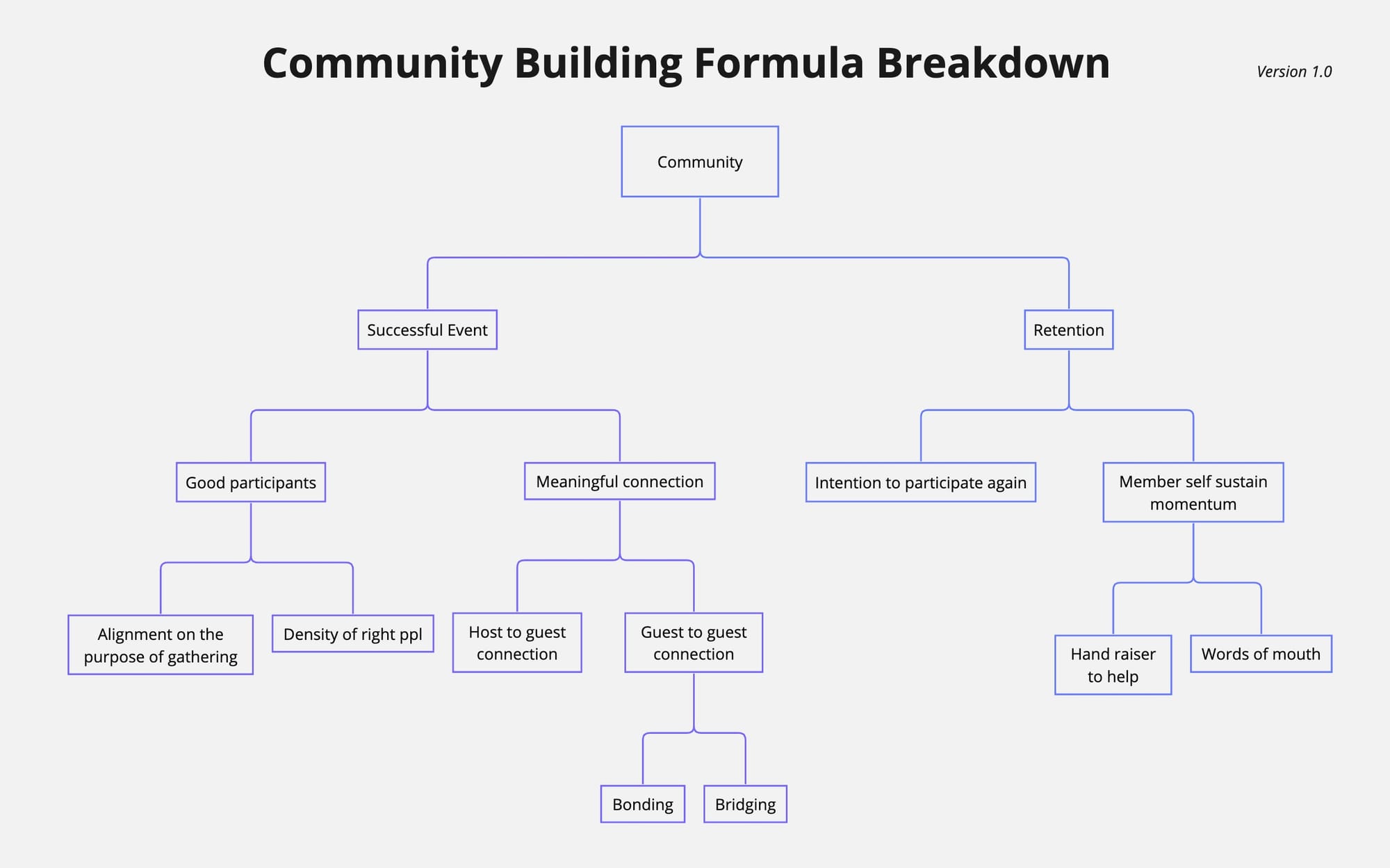Community Building Framework - Key Components of Community

Many people believe connection and community are organic things, however, can we distil some key components of a successful and sustainable community? Can we break it down into several parts to improve each aspect?
These questions occupy my mind as I run Casual Tech Meetup, a community I founded last year. We aim to curate transformative gatherings for change-makers, technologists, and trailblazers.
After hosting 12 events in 12 months, talking to participants, observing how others run communities and reading books about gathering and community. I came up with this formula and framework.
Community Building Formula
Successful Event = Good Participant x Meaningful connection
Community = Good Participant x Meaningful connection x Retention
Consider it as a math formula, a community means successful events with retention, while successful events require good participants with meaningful connections. Therefore a community require good participants with meaningful connection and retention.
Community Building Formula Breakdown
This is a more detailed breakdown of what good participants, meaningful connection and retention mean.

1 - Good Participants
1.1 - Density of right people :
When running a community, the first thing that comes to mind is: who will be your ideal member? This could involve specific profiles, such as their title, industry, common interests, or more abstract traits centred on personality.
However, specificity shouldn't imply exclusivity. It's entirely possible to have a diverse group of members while still establishing a common group among them. It can be achieved by bonding and bridging participants.
1.2 - Alignment on the purpose of gathering:
When attendees desire to engage in a round-table discussion on a particular topic for knowledge-sharing, but the host intends to run a casual mixer session without actively facilitating conversation, a misalignment of purposes occurs. This mismatch leads to frustration for both hosts and guests.
That's why it's crucial to explicitly state the purpose of the event you're hosting. Even if fewer people attend, they'll understand what they can gain from it.
2 - Meaningful connection
2.1 - Host-to-guest connection
Upon a guest's arrival, can the host give out a welcoming vibe? If the guest doesn't know anyone, will the host engage them, making them feel comfortable, and gradually introduce them to others? This is what I will consider the host-to-guest connection.
Another essential aspect is understanding your guests well. Are you genuinely curious about them? Through their social media presence and your understanding of each individual, you can discover topics that genuinely interest you as a host. People can sense your interest in conversing with them.
Limiting the number of participants allows for more time to be spent with each guest, fostering stronger connections.
2.2 - Guest-to-guest connection
Community is about bonding and bridging members. Bonding is within a group, they might have similar social circles, backgrounds and hobbies whereas bridging is between social groups and backgrounds. You can achieve both by introducing guests to each other or applying predefined rules and formats in structured events.
In events I previously co-hosted, we utilized methodologies like Lego Serious Play and World Cafe for discussions. Both methods have clear rules. For instance, in the World Cafe style, participants form groups of four to share, and then three members move to another group. This fosters evolving dialogues and collective wisdom.
Maintaining a connector mindset in every event can help foster connections between hosts and guests and among guests themselves.
3 - Member Retention
Retention can be considered a lagging indicator for your entire community experience; it reflects what has already occurred.
3.1 - Intention to participate again
A community consists of individuals who are willing to consistently return and gather. Their intention to participate in your next event serves as a important indicator of the community's sustainability.
The truth is, you'll have to exceed expectations with your activities if you want people to keep returning. This relates to the previous section - meaningful guest-to-guest connections, density of the right people, and alignment of the purpose.
When these three aspects are executed effectively, the event stands a better chance of exceeding expectations, resulting in sustained attendance.
3.2 - Member Self-Sustaining Momentum
Another way to improve retention is by identifying and nurturing hand-raisers and word-of-mouth advocates. Engage participants who are active in events, willing to assist in the next one, share with their friends, and invite others to join.
Ask them why they are committed to the event and what their aspirations are. They will become the core members of your community, pushing the group forward and expanding what's possible.
Ultimately, you can't build a community alone. What you need to do to sustain a community is to create more community leaders - finding, vetting, and collaborating with them.
Book recommendations on community building
- The Art of Gathering by Priya Parker
- Get Together: How to Build a Community with Your People by Bailey Richardson, Kevin Huynh, and Kai Elmer Sotto
- Superconnector: Stop Networking and Start Building Business Relationships that Matter by Scott Gerber and Ryan Paugh
- The Power of Moments: Why Certain Experiences Have Extraordinary Impact by Chip Heath and Dan Heath
- Switch: How to Change Things When Change Is Hard by Chip Heath and Dan Heath
- Unreasonable Hospitality: The Remarkable Power of Giving People More Than They Expect by Will Guidara
- Bowling Alone: The Collapse and Revival of American Community by Robert D. Putnam
Member discussion